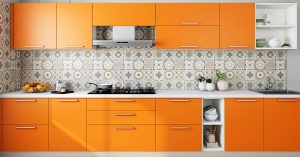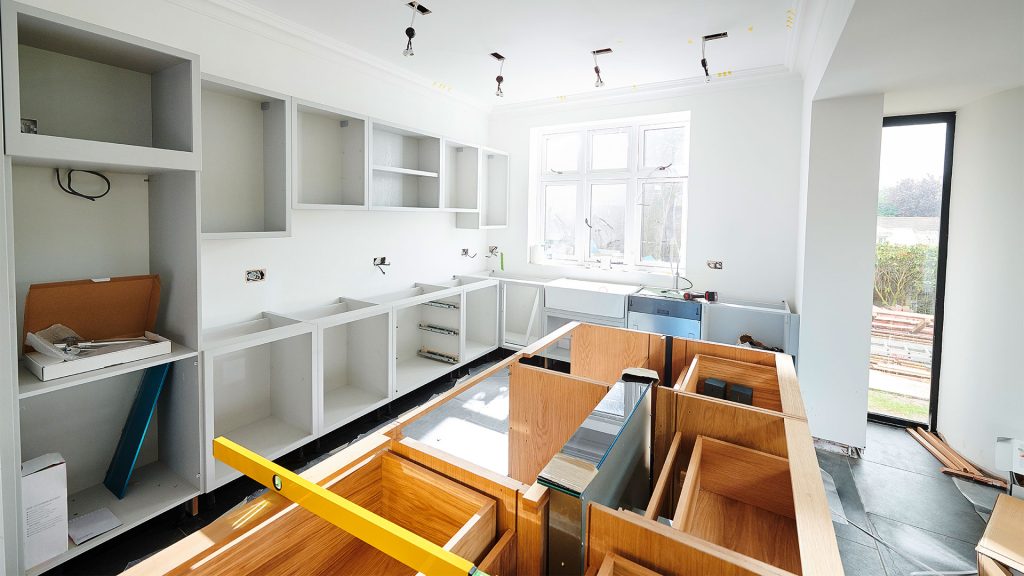How to pick the best loan for home improvements
Home renovations can be expensive. But the good news is that you don’t have to pay out of pocket.
Home improvement loans let you finance the cost of upgrades and repairs to your home.
Some — like the FHA 203(k) mortgage — are specialized for home renovation projects, while second mortgage options — like home equity loans and HELOCs — can provide cash for a remodel or any other purpose. Your best financing option for home improvements depends on your needs. Here’s what you should know.
Check home improvement loan options and rates. Start here
In this article (Skip to…)
What is a home improvement loan?
A home improvement loan is a financial tool that allows you to borrow money for various home projects, such as repairs, renovations, or upgrades.
Unlike a secured loan like a second mortgage, home improvement loans are often unsecured personal loans, meaning you don’t have to put up your home as collateral. You get the money in a lump sum and pay it back over a predetermined period, which can range from one to seven years.
Now, you might be wondering how this is different from a home renovation loan. While the terms are often used interchangeably, there can be subtle differences.
Home improvement loans are generally more flexible and can be used for any type of home project, from installing a new roof to landscaping. Home renovation loans, on the other hand, are often more specific and may require you to use the funds for particular types of renovations, like kitchen or bathroom remodels.
How does a home improvement loan work?
So, you’ve decided to spruce up your home, and you’re considering a home improvement loan. But how does it work? Once you’re approved, the lender will give you the money in a lump sum. You start repaying the loan almost immediately, usually in fixed monthly installments. The interest rate you’ll pay depends on various factors, including your credit score and the lender’s terms.
Be mindful of additional costs like origination fees, which can range from 1% to 8% of the loan amount. Unlike a credit card, where you can keep using the available credit as you pay it off, the loan amount is fixed. If you find that you need more money for your project, you’ll have to apply for another loan, which could affect your credit score.
Home improvement loan rates
Interest rates for home improvement loans can vary widely, generally ranging from 5% to 36%. Your credit score plays a significant role in determining your rate—the better your credit, the more favorable your rate. Some lenders even offer an autopay discount if you link a bank account for automatic payments.
You can also prequalify to check your likely interest rate without affecting your credit score, making it easier to plan for the loan purpose, whether it’s a new kitchen or fixing a leaky roof.
So, whether you’re dreaming of solar panels or finally fixing up your master bedroom, a home improvement loan can be a practical way to finance your projects. Just make sure to read the fine print and understand all the terms, including any potential autopay discounts and bank account requirements, before you apply.
Types of home improvement loans
1. Home equity loan
A home equity loan (HEL) is a financial instrument that lets you borrow money using the equity you’ve built up in your home as collateral. The equity is determined by subtracting your existing mortgage loan balance from your current home value. Unlike a cash-out refinance, a home equity loan “issues loan funding as a single payment upfront. It’s similar to a second mortgage,” says Bruce Ailion, Realtor and real estate attorney. “You would continue making payments on your original mortgage while repaying the home equity loan.”
Check home equity loan options and rates. Start here
This kind of loan is particularly useful for big, one-time expenditures like home remodeling. It offers a fixed interest rate, and the loan terms can range from five to 30 years. You could potentially borrow up to 100% of your home’s equity.
However, there are some cons to consider. Since you’re essentially taking on a second loan, you’ll have an additional monthly payment if you still have a balance on your original mortgage. Also, the lender will usually charge closing costs ranging from 2% to 5% of the loan balance, as well as potential origination fees. Because the loan provides a lump-sum payment, careful budgeting is necessary to ensure the funds are used effectively.
As a bonus, “a home equity loan, or HELOC, may also be tax-deductible,” says Doug Leever with Tropical Financial Credit Union, member FDIC. “Check with your CPA or tax advisor to be sure.”
2. HELOC (home equity line of credit)
A Home Equity Line of Credit (HELOC) is another option for tapping into your home’s equity without going through the process of a full refinance. Unlike a standard home equity loan that provides a lump sum upfront, a HELOC functions more like a credit card. You’re given a pre-approved limit and can borrow against that limit as you need, paying interest only on the amount you’ve actually borrowed.
Check your HELOC options. Start here
While there’s more flexibility because you don’t have to borrow the entire amount at once, be aware that by the end of the term, “the loan must be paid in full. Or the HELOC can convert to an amortizing loan,” says Ailion. “Note that the lender can be permitted to change the terms over the loan’s life. This can reduce the amount you can borrow if, for instance, your credit goes down.”
The pros of a HELOC include minimal or potentially no closing costs, and loan payments that vary according to how much you’ve borrowed. It offers a revolving balance, which means you can re-use the funds after repayment. This kind of financial instrument may be ideal for ongoing or long-term projects that don’t require a large sum upfront.
“HELOCs offer flexibility, and you only pull money out when needed, within the maximum loan amount. And the credit line is available for up to 10 years, which is your repayment period.” Leever says.
3. Cash-out refinance
A cash-out refinance is a viable option if you’re considering home improvements or other significant financial needs. When opting for a cash-out refinance, you essentially take on a new, larger mortgage than your existing one and then pocket the difference in cash.
This cash comes from your home’s value and can be used for various purposes, including home improvement projects like finishing a basement or remodeling a kitchen. However, the money can also be used for other things, like paying off high-interest debt, covering education expenses, or even buying a second home. Importantly, a cash-out refinance is most beneficial when current market rates are lower than your existing mortgage rate.
Check your eligibility for a cash-out refinance. Start here
The advantages of going for a cash-out refinance include the opportunity to reduce your mortgage rate or loan term, which could potentially result in paying off your home earlier. For instance, if you initially had a 30-year mortgage with 20 years remaining, you could refinance to a 15-year loan, effectively paying off your home five years ahead of schedule. Plus, you only have to worry about one mortgage payment.
However, there are downsides. Cash-out refinances tend to have higher closing costs that apply to the entire loan amount, not just the cash you’re taking out. The new loan will also have a larger balance than your current mortgage, and refinancing effectively restarts your loan term length.
4. FHA 203(k) rehab loan
The FHA 203(k) rehab loan is backed by the Federal Housing Administration that consolidates the cost of a home mortgage and home improvements into a single loan, which makes it particularly useful for those buying fixer-uppers.
Check your eligibility for an FHA 203(k) loan. Start here
With this program, you don’t need to apply for two different loans or pay closing costs twice; you finance both the house purchase and the necessary renovations at the same time. The loan comes with several benefits like a low down payment requirement of just 3.5% and a minimum credit score requirement of 620, making it accessible even if you don’t have perfect credit. Additionally, first-time home buyer status is not a requirement for this loan.
However, there are some limitations and downsides to be aware of. The FHA 203(k) loan is specifically designed for older homes in need of repairs, rather than new properties. The loan also includes both upfront and ongoing monthly mortgage insurance premiums. Renovation costs have to be at least $5,000, and the loan restricts the use of funds to certain approved home improvement projects.
According to Jon Meyer, a loan expert at The Mortgage Reports, “FHA 203(k) loans can be drawn out and difficult to get approved. If you go this route, it’s important to choose a lender and loan officer familiar with the 203(k) process.”
5. Unsecured personal loan
If you’re looking to finance home improvements but don’t have sufficient home equity, a personal loan could be a viable option. Unlike home equity lines of credit (HELOCs), personal loans are unsecured, meaning your home is not used as collateral. This feature often allows for a speedy approval process, sometimes getting you funds on the next business day or even the same day.
Check home improvement loan options and rates. Start here
The repayment terms for personal loans are less flexible, usually ranging between two and five years. Although you’ll most likely face closing costs, personal loans can be easier to access for those who don’t have much home equity to borrow against. They can also be a good choice for emergency repairs, such as a broken water heater or HVAC system that needs immediate replacement.
However, there are notable downsides to consider. Unsecured personal loans generally have higher interest rates compared to HELOCs and lower borrowing limits. The short repayment terms could put financial strain on your budget. Additionally, you may encounter prepayment penalties and expensive late fees. Financial expert Meyer describes personal loans as the “least advisable” option for homeowners, suggesting that they should be considered carefully and perhaps as a last resort.
6. Credit cards
Using a credit card can be the fastest and most straightforward way to finance your home improvement projects, eliminating the need for a lengthy loan application. However, you’ll need to be cautious about credit limits, especially if your renovation costs are high.
You might need a card with a higher limit or even multiple cards to cover the costs. The interest rates are generally higher compared to home improvement loans, but some cards offer an introductory 0% annual percentage rate (APR) for up to 18 months, which can be a good deal if you’re sure you can repay the balance within that time frame.
Check home improvement loan options and rates. Start here
Credit cards might make sense in emergency situations where you need immediate funding. For longer-term financing, though, they’re not recommended. If you do opt for credit card financing initially, you can still get a secured loan later on to clear the credit card debt, thus potentially saving on high-interest payments.
How do you choose the best home improvement loan for you?
The best home improvement loan will match your specific lifestyle needs and unique financial situation. So let’s narrow down your options with a few questions.
Check your home improvement loan options. Start here
Do you have home equity available?
If so, you can access the lowest rates by borrowing against the equity in your home with a cash-out refinance, a home equity loan, or a home equity line of credit.
Here are a few tips for choosing between a HELOC, home equity loan, or cash-out refi:
- Can you get a lower interest rate? If so, a cash-out refinance could save money on your current mortgage and your home improvement loan simultaneously
- Are you doing a big, single project like a home remodel? Consider a simple home equity loan to tap into your equity at a fixed rate
- Do you have a series of remodeling projects coming up? When you plan to remodel your home room by room or project by project, a home equity line of credit (HELOC) is convenient and worth the higher loan rate compared to a simple home equity loan
Are you buying a fixer-upper?
If so, check out the FHA 203(k) program. This is the only loan on our list that bundles home improvement costs with your home purchase loan. Just review the guidelines with your loan officer to ensure you understand the disbursement of funds rules.
Taking out just one mortgage to cover both needs will save you money on closing costs and is ultimately a more straightforward process.
“The only time I’d recommend the FHA203(k) program is when buying a fixer-upper,” says Meyer. “But I would still advise homeowners to explore other loan options as well.”
Do you need funds immediately?
When you need an emergency home repair and don’t have time for a loan application, you may have to consider a personal loan or even a credit card.
Which is better?
- Can you get a credit card with an introductory 0% APR? If your credit history is strong enough to qualify you for this type of card, you can use it to finance emergency repairs. But keep in mind that if you’re applying for a new credit card, it can take up to 10 business days to arrive in the mail. Later, before the 0% APR promotion expires, you can get a home equity loan or a personal loan to avoid paying the card’s variable-rate APR
- Would you prefer an installment loan with a fixed rate? If so, apply for a personal loan, especially if you have excellent credit
Just remember that these options have significantly higher rates than secured loans. So you’ll want to reign in the amount you’re borrowing as much as possible and stay on top of your payments.
How to get a home improvement loan
Getting a home improvement loan is similar to getting a mortgage. You’ll want to compare rates and monthly payments, prepare your financial documentation, and then apply for the loan.
Check home improvement loan options and rates. Start here
1. Check your financial situation
Check your credit score and debt-to-income ratio. Lenders use your credit report to establish your creditworthiness. Generally speaking, lower rates go to those with higher credit scores. You’ll also want to understand your debt-to-income ratio (DTI). It tells lenders how much money you can comfortably borrow.
2. Compare lenders and loan types
Gather loan offers from multiple lenders and compare costs and terms with other types of financing. Look for any benefits, such as rate discounts, a lender might provide for enrolling in autopay. Also, keep an eye out for disadvantages, including minimum loan amounts or expensive late payment fees.
3. Gather your loan documents
Be prepared to verify your income and financial information with documentation. This includes pay stubs, W-2s (or 1099s if you’re self-employed), and bank statements, to name a few.
4. Complete the loan application process
Depending on the lender you choose, you may have a fully online loan application, one that is conducted via phone and email, or even one that is conducted in person at a local branch. In some cases, your mortgage application could be a mix of these options. Your lender will review your application and likely order a home appraisal, depending on the type of loan. You’ll get approved and receive funding if your finances are in good shape.
Get started on your home improvement loan. Start here
Home improvement loan lenders
When considering a home improvement loan, it’s necessary to explore various lending options to find the one that best suits your needs. The lending landscape for home improvement is diverse, featuring traditional banks, credit unions, and online lenders. Each type of lender offers different interest rates, loan terms, and eligibility criteria.
It’s advisable to prequalify with multiple lenders to get an estimate of your loan rates, which generally doesn’t affect your credit score. This way, you can compare offers and choose the most favorable terms for your renovation project.
Among the popular choices in the market, Sofi and LightStream stand out for their competitive rates, easy online application, and customer-friendly terms. Both are equal housing lenders, ensuring they adhere to federal anti-discrimination laws. In addition to these, other lenders like Wells Fargo and LendingClub also offer home improvement loans with varying terms and conditions.
How can I use the money from a home improvement loan?
When you do a cash-out refinance, a home equity line of credit, or a home equity loan, you can use the proceeds on anything — even putting the cash into your checking account. You could pay off credit card debt, buy a new car, pay off student loans, or even fund a two-week vacation. But should you?
It’s your money, and you get to decide. But spending home equity on improving your home is often the best idea because you can increase the value of your home. Spending $40,000 on a new kitchen remodel or $20,000 on finishing your basement could add significant value to your home. And that investment would be appreciated along with your home.
That said, if you’re paying tons of interest on credit card debt, using your home equity to pay that off would make sense, too.
Average costs of home renovations
Home renovations can vary widely in cost depending on the scope of the project, the quality of the materials used, and the region where you live. However, here’s a general idea of what you might expect to pay for various types of home renovations.
| Renovation Type | Average Cost Range |
| Kitchen Remodel | $10,000 – $50,000 |
| Bathroom Remodel | $5,000 – $25,000 |
| Master Bedroom Remodel | $1,500 – $10,000 |
| New Roof | $5,000 – $11,000 |
| Exterior Paint | $6,000 – $20,000 |
| Interior Paint | $1,500 – $10,000 |
| New Deck | $15,000 – $40,000 |
| Solar Panel Installation | $15,000 – $25,000 |
| Window Replacement | $5,000 – $15,000 |
The information is based on data from HomeGuide.com and is current as of August 2023.
Please note that these are just average figures, and the actual costs can vary. For instance, a high-end kitchen remodel could cost significantly more, especially if you’re planning to use custom cabinetry and high-end appliances. Similarly, the cost of a new deck can vary depending on the size and type of materials used.
Home improvement loans FAQ
Check home improvement loan options and rates. Start here
The best loan for home improvements depends on your finances. If you have accumulated a lot of equity in your home, a HELOC, or home equity loan, might be suitable. Or, you might use a cash-out refinance for home improvements if you can also lower your interest rate or shorten the current loan term. Those without equity or refinance options might use a personal loan or credit cards to fund home improvements instead.
That depends. We’d recommend looking at your options for a refinance or home equity-based loan before using a personal loan for home improvements. That’s because interest rates on personal loans are often much higher. But if you don’t have a lot of equity to borrow from, using a personal loan for home improvements might be the right move.
The credit score requirements for a home improvement loan depend on the loan type. With an FHA 203(k) rehab loan, you likely need a good credit score of 620 or higher. Cash-out refinancing typically requires at least 620. If you use a HELOC, or home equity loan, for home improvements, you’ll need a FICO score of 680–700 or higher. For a personal loan or credit card, aim for a score in the low-to-mid 700s. These have higher interest rates than home improvement loans, but a stronger credit profile will help lower your rate.
If you’re buying a fixer-upper or renovating an older home, the best renovation loan might be the FHA 203(k) mortgage. The 203(k) rehab loan lets you finance (or refinance) the home and renovation costs into a single loan, so you avoid paying double closing costs and interest rates. If your home is newer or of higher value, the best renovation loan is often a cash-out refinance. This lets you tap the equity in your current home and refinance into a lower mortgage rate at the same time.
Home improvement loans are generally not tax-deductible. However, if you finance your home improvement using a refinance or home equity loan, some of the costs might be tax-deductible.
Disclaimer: The Mortgage Reports do not provide tax advice. Be sure to consult a tax professional if you have any questions about your taxes.
Shop around for your best home improvement loan
As with anything in life, it pays to compare all your options. So don’t just settle on the first loan offer you find.
Compare lenders, mortgage types, rates, and terms carefully to find the best loan for home improvements.
Time to make a move? Let us find the right mortgage for you
Read the full article here














